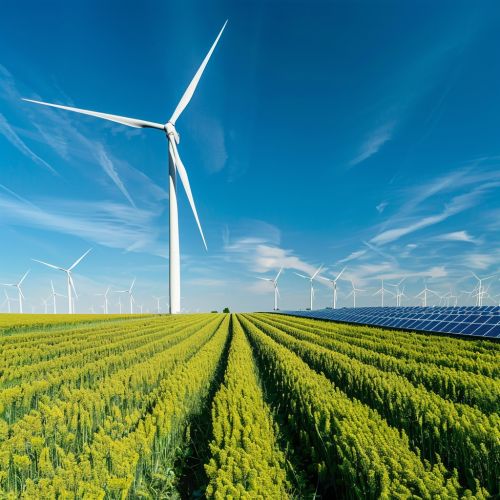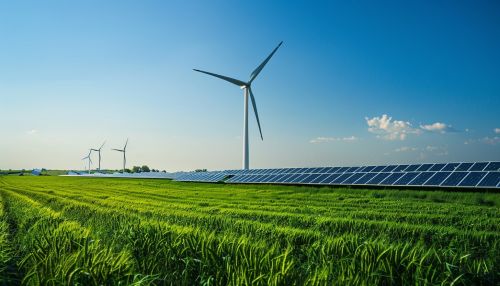Energy policy
Introduction
Energy policy encompasses the measures and strategies adopted by a government or organization to manage and regulate the production, distribution, and consumption of energy. It involves a wide array of considerations, including economic, environmental, and social factors. The primary goals of energy policy typically include ensuring a reliable supply of energy, promoting energy efficiency, and reducing the environmental impact of energy production and consumption.
Historical Context
Energy policy has evolved significantly over time, influenced by technological advancements, economic shifts, and geopolitical developments. In the early 20th century, energy policies were primarily focused on the development of fossil fuels such as coal, oil, and natural gas. The mid-20th century saw the rise of nuclear energy as a significant component of national energy strategies. The late 20th and early 21st centuries have been marked by a growing emphasis on renewable energy sources and sustainability.
Key Components of Energy Policy
Energy Security
Energy security refers to the uninterrupted availability of energy sources at an affordable price. It is a critical aspect of national security and economic stability. Policies aimed at enhancing energy security often involve diversifying energy sources, investing in domestic energy production, and maintaining strategic petroleum reserves.
Energy Efficiency
Energy efficiency involves using less energy to perform the same task or produce the same outcome. Policies promoting energy efficiency can include regulations on appliance standards, building codes, and industrial processes. Energy efficiency is seen as a cost-effective way to reduce energy consumption and lower greenhouse gas emissions.
Renewable Energy
Renewable energy sources, such as solar, wind, hydro, and geothermal, are increasingly prioritized in energy policies due to their sustainability and lower environmental impact. Governments may implement incentives such as tax credits, subsidies, and feed-in tariffs to encourage the adoption of renewable energy technologies.
Policy Instruments
Regulatory Measures
Regulatory measures are rules and standards set by governments to control the energy market. These can include emissions standards, renewable energy mandates, and efficiency requirements. Regulatory measures are essential for ensuring compliance with environmental goals and promoting fair competition in the energy market.
Economic Incentives
Economic incentives are financial mechanisms designed to encourage specific behaviors or investments in the energy sector. These can include subsidies for renewable energy projects, tax incentives for energy-efficient appliances, and grants for research and development in new energy technologies.
Market-Based Instruments
Market-based instruments use market signals to influence energy production and consumption. Examples include carbon pricing mechanisms such as carbon taxes and cap-and-trade systems. These instruments aim to internalize the environmental costs of energy production and create economic incentives for reducing emissions.
Environmental Considerations
Energy production and consumption have significant environmental impacts, including air and water pollution, habitat destruction, and climate change. Energy policies must balance the need for energy with the imperative to protect the environment. This can involve setting emissions reduction targets, promoting clean energy technologies, and implementing conservation measures.
Social and Economic Impacts
Energy policies can have wide-ranging social and economic impacts. Access to affordable energy is crucial for economic development and quality of life. Policies must consider the needs of different social groups, including low-income households and rural communities. Additionally, the transition to renewable energy can create new economic opportunities and jobs, but it may also pose challenges for workers in traditional energy industries.
International Energy Policy
Energy policy is not confined to national borders; it has significant international dimensions. Countries often collaborate on energy issues through international organizations such as the International Energy Agency (IEA) and the United Nations Framework Convention on Climate Change (UNFCCC). International energy policy can involve agreements on emissions reductions, technology transfer, and energy trade.
Case Studies
United States
The energy policy of the United States has evolved over time, with significant shifts in focus and strategy. The Energy Policy Act of 2005, for example, aimed to address energy production, efficiency, and renewable energy. More recently, the Biden administration has emphasized climate change and renewable energy, setting ambitious targets for reducing greenhouse gas emissions and increasing the use of clean energy.
European Union
The European Union has been a leader in promoting renewable energy and reducing emissions. The EU's energy policy is guided by the European Green Deal, which aims to make Europe the first climate-neutral continent by 2050. Key initiatives include the Emissions Trading System (ETS), the Renewable Energy Directive, and the Energy Efficiency Directive.
China
China's energy policy has focused on balancing rapid economic growth with environmental sustainability. The country has made significant investments in renewable energy and is the world's largest producer of solar panels and wind turbines. China's 14th Five-Year Plan emphasizes the transition to a low-carbon economy and the development of clean energy technologies.
Challenges and Future Directions
Energy policy faces several challenges, including the need to transition to a low-carbon economy, ensure energy security, and address social equity. Future directions in energy policy may involve greater integration of renewable energy, advancements in energy storage and grid technology, and the development of new policy frameworks to address emerging issues such as climate change and energy justice.


